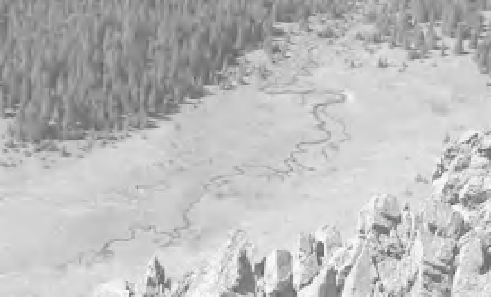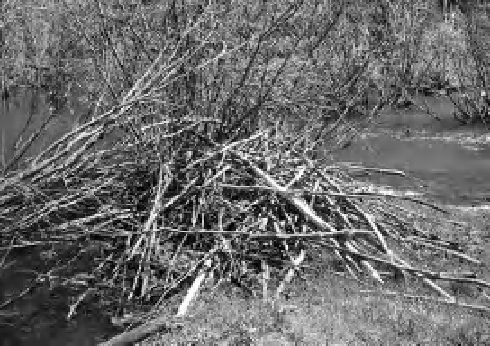Geoscience Reference
In-Depth Information
A
B
Figure 17-13.
Newly built beaver lodge beside
Cucharas Creek, downstream from the Blue-Bear Lakes
moraine complex. Photo by J.S. Aber.
insulating effect of peat and snow cover prevents
freezing at shallow depth in the mire throughout
the long, cold winter, which has important impli-
cations for year-round biological activity and
organic conditions in the shallow peat.
Several shallow and one long peat cores
were acquired also from the beaver mire. The
shallow peat is dominated by slimstem reedgrass
and displays a high degree of decomposition
of plant remains (Volkova, pers. com. 2006).
Near the center of the mire, peat is at least
2.5 m deep; basal peat yielded a corrected cal-
endar age of 3700 to 3630 years (Beta 232587).
Given a maximum age of 3700 years and thick-
ness of 2.5 m, the average rate of peat accumu-
lation would be about two-thirds of a mm per
year. However, this site has been disturbed
repeatedly by beaver, which undoubtedly
altered water levels and, thus, vegetation and
peat accumulation.
Both mires began accumulating peat during
the Neoglacial period of cooler, wetter climate
in the late Holocene. This suggests that moraine
lake ini lling and hydroseral succession required
several millennia after the late Pinedale glaciers
disappeared in order to reach the status wherein
plant remains could form peat. The southwest-
ern United States was markedly warmer and
drier during the mid-Holocene altithermal
episode (Polyak et al. 2001), when most lakes
in this vicinity may have dried up. This condi-
tion happens even nowadays during short-term
C
Figure 17-12.
Alpine wetlands at the head of
Trinchero Creek valley on the northwestern side of
Trinchera Peak; elevation of valley l oor
∼
3600 m. A.
Overview of meandering stream and wet meadow
(right) and small basin with pond (left). B. Close-up
view of meandering Trinchero Creek and wet meadow.
The stream is fed by a spring that emerges along a
fault zone (see Fig. 4-8). C. Basin formed by ridge of
bedrock mantled by moraine. Photos by J.S. Aber.
then begins to increase again in June and July.
This region is currently included in plant hardi-
ness zone 5, in which minimum winter air tem-
perature is typically in the range
−
−
10 to
20 °F
−
−
(
23 to
29 °C) (Arbor Day 2006). However, the








